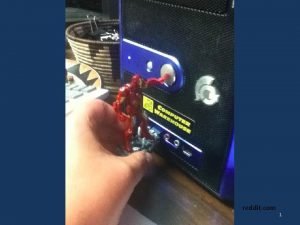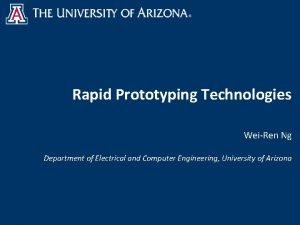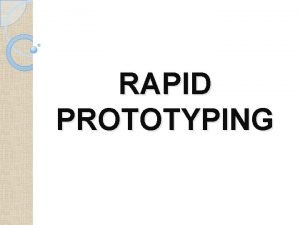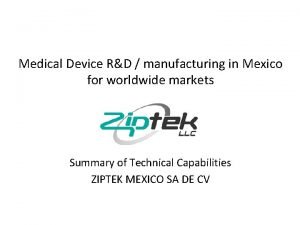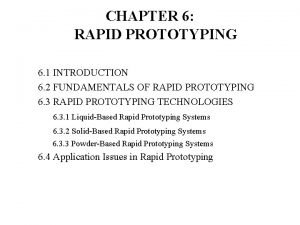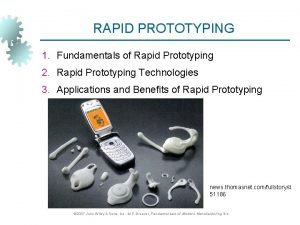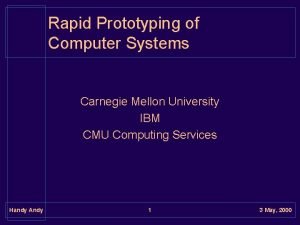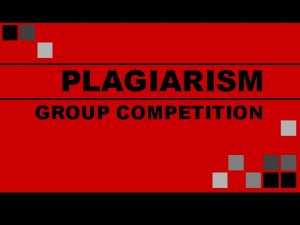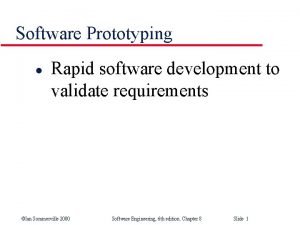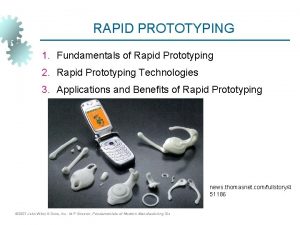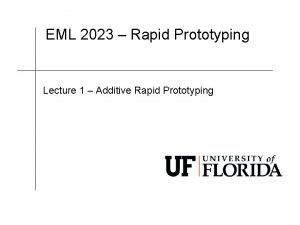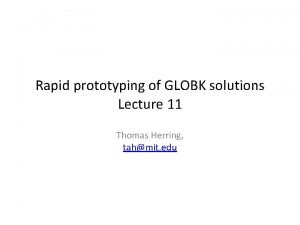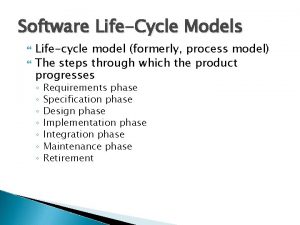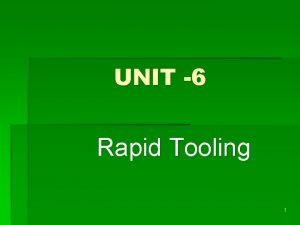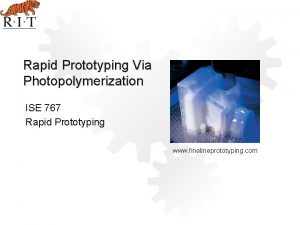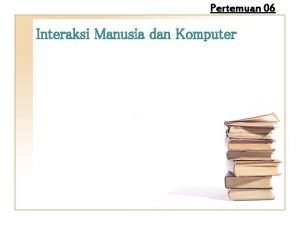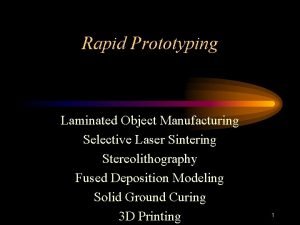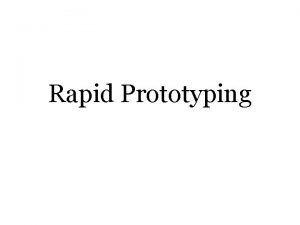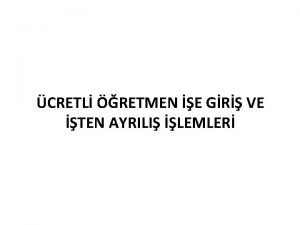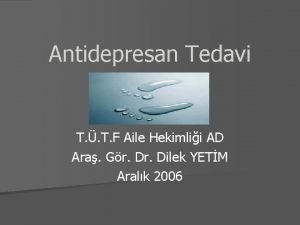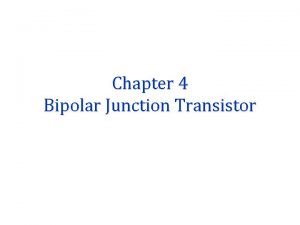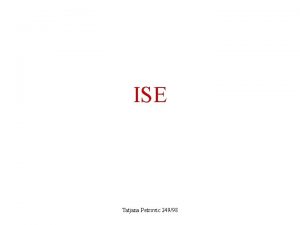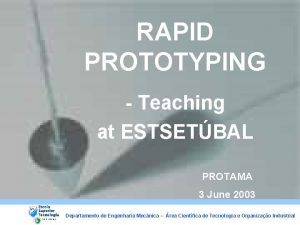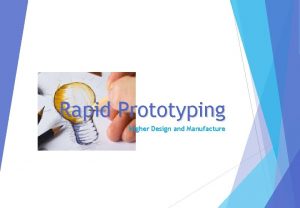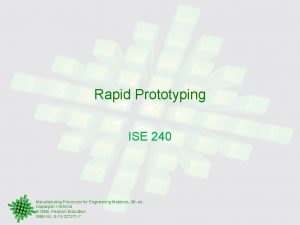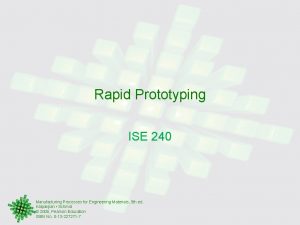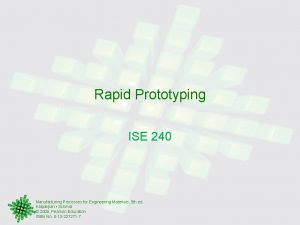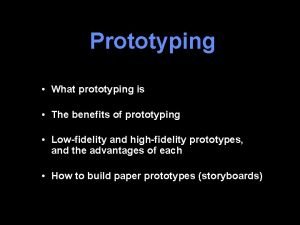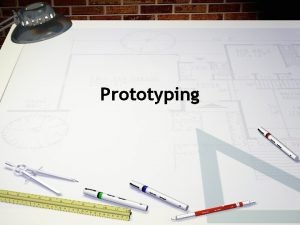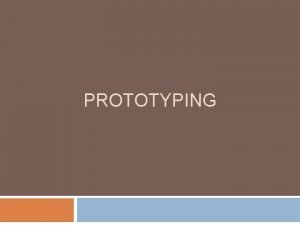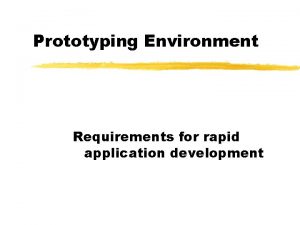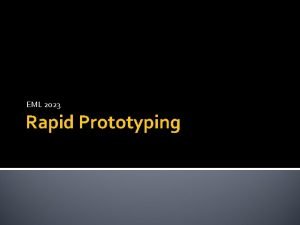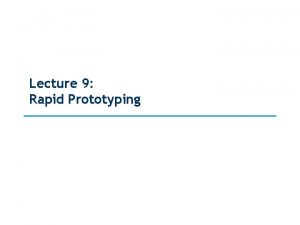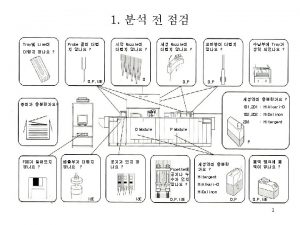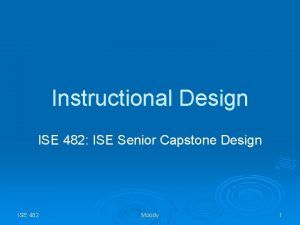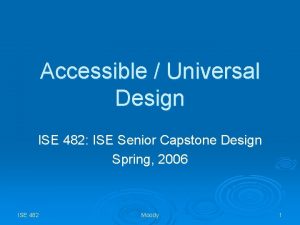Rapid Prototyping Via Photopolymerization ISE 767 Rapid Prototyping































- Slides: 31

Rapid Prototyping Via Photopolymerization ISE 767 Rapid Prototyping www. finelineprototyping. com

Introduction § Numerous commercially available RP systems are based upon the principle of photopolymerization. § The aims of this module are: § To provide you with an overview of which systems are available, and what their operating principle is. § To introduce theory behind light-resin interactions as a means of explaining some of the dozens of process parameters you can control when using one of these systems.

Part I – Commercially Available Systems © 2007 John Wiley & Sons, Inc. M P Groover, Fundamentals of Modern Manufacturing 3/e

3 D Systems Stereolithography § http: //www. youtube. com/watc h? v=NRc 8 y. P-YM 1 A § SLA Viper § 355 nm solid state Nd: YVO 4 laser up to 100 m. W § Dual resolution § 0. 25 mm or 0. 075 mm beam diameter

CAD-To-SLA Process § CAD models are saved as STL files § Models are brought into the Lightyear software § Translated, rotated, scaled, copied as needed § Nest as many parts on the platform as possible § STL files are verified to ensure that the surfaces are water tight § Supports are generated beneath downward-facing surfaces § The build is sliced § The slice images to be drawn by the laser are stored in a new slice file format read by the SLA machine

SLA Postprocessing § § Support removal Cleaning uncured resin with TPM or alcohol Postcuring Sanding

SLA Tempering § § http: //home. att. net/~edgrenda/pow 21. htm SLA parts are typically more brittle than thermoplastic resins A patented tempering process (see photos and article above) calls for fabricating parts with small channels. A composite material is injected into the channels that dramatically increases impact resistance and flexibility. Untempered SLA parts Tempered SLA parts Source: http: //home. att. net/~edgrenda/pow 21. htm

Sony – Solid Creation System § Identical in concept to 3 D Systems stereolithography process § Systems available with § Two lasers for faster builds § 1, 000 m. W lasers (our SLA has a 40 m. W laser!) § Adjustable laser spot size and layer thickness during the build Source: www. sonysms. com

3 D Systems - Pro. Jet § http: //www. youtube. com/wat ch? v=5 hhn. XFmd. UHQ § Multi-jet inkjet printing of UV curable photo-polymer. § UV flood lamp curing after printing of each layer § Two resolutions available § SR model: 0. 003" resolution in X, Y and 0. 0016" in Z § HR model: 0. 0015" resolution in X, Y and 0. 0016" in Z Source: www. 3 dsystems. com

Objet - Eden § http: //www. youtube. com/wat ch? v=r_2 -4 SFls. Hk § Array of 8 inkjet print heads scan back and forth jetting a photopolymer onto the platform § UV lamp cures the photopolymer (no laser) § Support material is removed with warm water § Suitable for printing parts with extremely fine details § 600 μm thick walls, 16 μm layer thickness § New multi-material deposition capabilities! Source: www. 2 objet. com

Envisiontec - Perfactory § http: //www. youtube. com/watch? v=LZIy 4 LU-Qz 0 § Uses Texas Instruments DLP chip (same as that used in some projection TV's) to project a visible light image onto a visible light curing photo-polymer. § Two resolutions available: § Standard res: 148 μm in X, 93 μm in Y, and 50 to 150 thick layers § High resolution: 60 μm in X, 32 μm in Y, and 25 to 50 thick layers Source: www. envisiontec. de. com

V-Flash § 3 D Systems - $9, 900 § http: //www. youtube. com/wat ch? v=0 Rs 7 RQp. O 8 p 0 § Resin is printed onto plastic film. § A platform lowers down onto the film, thus transferring resin from the top of the film to the bottom of the plate. § UV light cures the resin, and the process is repeated. § The parts come out completely dry with no postprocessing needed.

Part II: The Science Behind Photopolymerization

Photopolymers § § § Highly crosslinked or networked polymers that effectively form a giant macromolecule Strong covalent bonds Cannot be melted once they've been cured Crosslinking significantly raises the glass transition temperature They are generally very resistant to solvents They can generally withstand higher temperatures than TP’s Source: www. pslc. ws/mactest/images/xlink 02. gif

Curing of Cross Linked Polymers § Light-curing § Photocuring resins that are liquid until exposed to light of a specific wavelength § Examples: 3 D Systems stereolithography, 3 D Systems Invision, Envisiontec Perfactory, Objet Eden § Heat activated § Thermoset in powder form is molded to a particular shape, and heat initiates molecular cross linking § No RP systems use this approach that I'm aware of § Catalyst and mix-based systems § When two components are mixed together, the resulting chemical reaction leads to the desired cross linking § Ex: polyurethane casting into rubber molds

Photopolymer Chemistry § Monomers, initiators, etc. § Radical photo-polymerization § Cationic photo-polymerization

Radical Polymerization § Used to photo-polymerize acrylate resins § Photons are absorbed by the photoinitiator thus producing free radicals § Only happens when laser power exceeds the threshold curing exposure § Photoinitiators are sensitive to a specific range of wavelengths (mostly in the UV range) § Free radicals react with monomer

Cationic Polymerization § Used for photo-polymerization of epoxy and vinylether resins § Higher strength and lower shrinkage § Oxygen will not inhibit reaction § Water (humidity) will inhibit reaction § Do not react as quickly, so a more powerful laser is needed to cure at the same rate as with acrylate resins.

Representative Material Properties Stereolithography Source: www. finelineprototyping. com

Photocuring § The process of hardening a liquid resin via the selective application of energy (UV, IR, etc). § Penetration Depth (Dp) – the depth at which the energy intensity has been reduced to approximately 1/3 the intensity at the surface. § Scan Velocity (Vs) – the speed (mm/sec) at which the laser beam is scanned over the liquid resin. § Critical Exposure (Ec) – the energy per unit area needed to produce gelation. § Cure depth (Cd) – is a function of penetration depth, critical exposure, energy intensity, exposure area, and exposure time.

Laser Exposure In Resin § Tells you the laser exposure (m. J/cm 2 or equivalent) as a function of depth beneath the surface of the resin (z) and distance from the center of the beam (y). § PL = laser power (m. W) § W 0 = 1/e 2 Gaussian half width of the beam (mm) § Vs = velocity of the beam (mm/sec) § Dp = penetration depth (mm) which is depth at which energy is 1/e that of energy at the surface Source: Laser-Induced Materials and Processes for RP by Fuh and Wong

Sample Calculation § What is the laser exposure (m. J/cm 2) at a depth of 0. 05 mm and a distance of 0. 03 mm from the center of the beam? § Given: § § § Z = 0. 05 mm and y = 0. 03 mm Laser power (PL) = 40 m. W W 0 = 0. 125 mm Vs = 200 mm/sec Dp = 0. 17 mm

Solution

Laser Exposure In Resin § Ec is the critical exposure level needed to initiate curing. § § § If energy density is less than Ec, then no curing takes place. If you know Ec, then you can determine the maximum value of y where curing takes place (i. e. you can figure out the width of the cured line at the surface Scan pitch is the step over distance between adjacent laser tracks when filling in an area. § § Many different fill strategies exist. In general, you don't want track lines from one layer exactly on top of track lines with previous layers as shown in the illustration. They are staggered to promote more complete curing They are often shifted 90 degrees in orientation between subsequent layers to balance shrinkage stresses that lead to curling. Source: Laser-Induced Materials and Processes for RP by Fuh and Wong

Cure Depth (Cd) § Maximum cure depth § Maximum exposure energy (Emax) § Laser velocity (Vs) to produce a desired cure depth ( )

Curling and Distortion § Curling of large flat horizontal surfaces is a significant problem. § Each layer shrinks during solidification. § When one layer shrinks on top of a previously solidified (preshrunk) layer, then there is stress between the two layers. § The result is curling § Preventing/minimizing curling § Re-orient the part if possible § Use lots of supports that anchor the downward facing surface in place. Source: Rapid Prototyping and Manufacturing by P. Jacobs

Beam Shape § A round laser beam that is projected straight down onto a perpendicular surface will produce a round spot. § When the beam is swept at an angle to other (non-perpendicular) spots on the vat of resin, the spot will have the shape of an oval. § Newer SLA machines (very expensive) have active optics that can reshape the spot on the fly in order to maintain a round spot anywhere on the surface of the resin. § Do print-based systems have this problem?

Electroplating of SLA Components § A handful of companies in the U. S. are able to electroplate SLA parts § Parts shown in the photos are nickel-plated SLA parts assembled into a functioning handheld air compressor (courtesy of Fineline Prototyping) Source: Fineline Prototyping

Plating of Plastics § Step 1: Make the surface electrically conducting § Brush on silver paint (typically shows poor adhesion) § Chromic acid will etch ABS plastic § Activate surface in palladium or tin chloride to deposit conducting metal into etched surface § Step 2: Very thin electroless nickel plating § Step 3: Electroplating with copper § Step 4 (Optional): Electroless nickel (or other metal) plating

Case Study: Invisalign Braces § Digital impression is made § Software creates steps of tooth movement § 12 -48 aligners, each of which is worn for about 6 weeks each § Each SLA machine makes ~100 unique aligner patterns per build § Polycarbonate/Polyurethane sheet 0. 030 -0. 040” thick is thermoformed over the SLA pattern © 2007 John Wiley & Sons, Inc. M P Groover, Fundamentals of Modern Manufacturing 3/e

Case Study: Hearing Aids § http: //www. materialise. com/materialise/view/en/ 2562804 Rapid+Shell+Modelling+%28 RSM%29. html § Download brochure © 2007 John Wiley & Sons, Inc. M P Groover, Fundamentals of Modern Manufacturing 3/e
 Horizontal prototype vs vertical prototype
Horizontal prototype vs vertical prototype Rapid prototyping
Rapid prototyping Rp techniques
Rp techniques Compare stl and slc file format
Compare stl and slc file format Mexico rapid prototyping
Mexico rapid prototyping Powder based rapid prototyping
Powder based rapid prototyping Solid based rapid prototyping systems
Solid based rapid prototyping systems Cmu rapid prototyping
Cmu rapid prototyping Rapid prototyping could be an advantageous methodology
Rapid prototyping could be an advantageous methodology Rapid prototyping software engineering
Rapid prototyping software engineering Waterfall v model
Waterfall v model Liquid based rapid prototyping system
Liquid based rapid prototyping system Rapid manufacturing wikipedia
Rapid manufacturing wikipedia Uf mae rapid prototyping
Uf mae rapid prototyping Rapid prototyping
Rapid prototyping Build and fix model has
Build and fix model has Copper polyamide rapid tooling
Copper polyamide rapid tooling Photopolymer
Photopolymer Rad design workshop
Rad design workshop Pengertian rapid prototyping
Pengertian rapid prototyping Lom rapid prototyping
Lom rapid prototyping Rapid prototyping definition
Rapid prototyping definition Via piramidal y via extrapiramidal
Via piramidal y via extrapiramidal Via crucis via lucis
Via crucis via lucis Palavras convergentes
Palavras convergentes Via positiva and via negativa
Via positiva and via negativa Estaciones de la resurrección
Estaciones de la resurrección Ayrili
Ayrili Tolvon iştah açar mı
Tolvon iştah açar mı Circuit symbols
Circuit symbols Cisco ise stealthwatch integration
Cisco ise stealthwatch integration Cisco ise ordering
Cisco ise ordering
